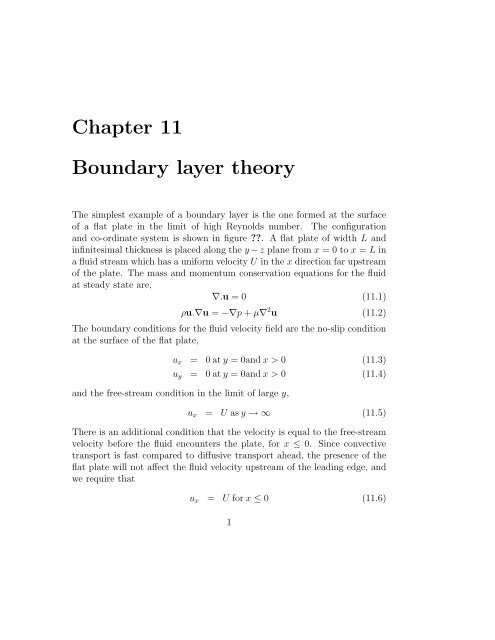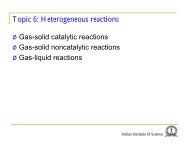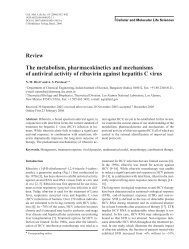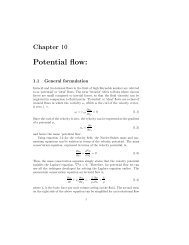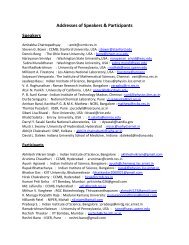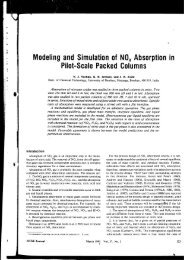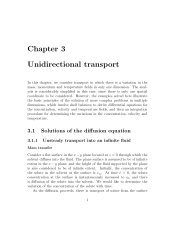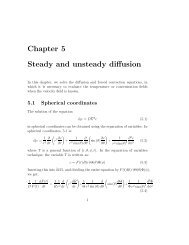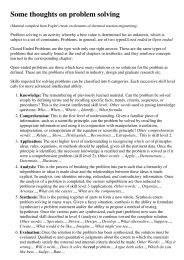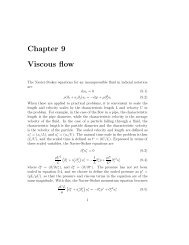Chapter 11 Boundary layer theory
Chapter 11 Boundary layer theory
Chapter 11 Boundary layer theory
Create successful ePaper yourself
Turn your PDF publications into a flip-book with our unique Google optimized e-Paper software.
<strong>Chapter</strong> <strong>11</strong><br />
<strong>Boundary</strong> <strong>layer</strong> <strong>theory</strong><br />
The simplest example of a boundary <strong>layer</strong> is the one formed at the surface<br />
of a flat plate in the limit of high Reynolds number. The configuration<br />
and co-ordinate system is shown in figure . A flat plate of width L and<br />
infinitesimal thickness is placed along the y −z plane from x = 0 to x = L in<br />
a fluid stream which has a uniform velocity U in the x direction far upstream<br />
of the plate. The mass and momentum conservation equations for the fluid<br />
at steady state are,<br />
∇.u = 0 (<strong>11</strong>.1)<br />
ρu.∇u = −∇p + µ∇ 2 u (<strong>11</strong>.2)<br />
The boundary conditions for the fluid velocity field are the no-slip condition<br />
at the surface of the flat plate,<br />
u x = 0 at y = 0and x > 0 (<strong>11</strong>.3)<br />
u y = 0 at y = 0and x > 0 (<strong>11</strong>.4)<br />
and the free-stream condition in the limit of large y,<br />
u x = U as y → ∞ (<strong>11</strong>.5)<br />
There is an additional condition that the velocity is equal to the free-stream<br />
velocity before the fluid encounters the plate, for x ≤ 0. Since convective<br />
transport is fast compared to diffusive transport ahead, the presence of the<br />
flat plate will not affect the fluid velocity upstream of the leading edge, and<br />
we require that<br />
u x = U for x ≤ 0 (<strong>11</strong>.6)<br />
1
2 CHAPTER <strong>11</strong>. BOUNDARY LAYER THEORY<br />
As we shall see later, though the point x = y = 0 is a mathematical singularity,<br />
this does not complicate the solution procedure for the velocity profile.<br />
The naive method for scaling the mass and momentum equations is to<br />
use scaled co-ordinates x ∗ = (x/L), y ∗ = (y/L) and u ∗ = (u/U), since L<br />
and U are the only length and velocity scales in the problem. The appropriate<br />
scaled pressure in the high Reynolds number limit is p ∗ = (p/ρU 2 ).<br />
Expressed in terms of the scaled velocity and pressure, the mass and momentum<br />
conservation equations are,<br />
∇ ∗ .u ∗ = 0 (<strong>11</strong>.7)<br />
u ∗ .∇ ∗ u ∗ = −∇p ∗ + Re −1 ∇ 2 u ∗ (<strong>11</strong>.8)<br />
In the limit of high Reynolds number, the viscous term (last term on the right<br />
side of equation <strong>11</strong>.8) is expected to be small compared to the inertial terms,<br />
and the momentum conservation equation reduces to that for the potential<br />
flow past a flat surface. However, as we have seen in the previous chapter, the<br />
potential flow equations can satisfy only the normal velocity condition at the<br />
surface of the flat plate, and cannot satisfy the condition on the tangential<br />
velocity u x in equation <strong>11</strong>.3. This is a familiar problem we have faced in flows<br />
where convection is large compared to diffusion, and is caused by the fact that<br />
when we neglect the diffusive effects, the conservation equation is converted<br />
from a second order to a first order differential equation. Consequently, it is<br />
not possible to satisfy all the boundary conditions which were specified for<br />
the original second order differential equation.<br />
The mass and momentum equations for the two-dimensional flow are,<br />
(<br />
∂u x<br />
ρ u x<br />
∂x + u y<br />
(<br />
∂u y<br />
ρ u x<br />
∂x + u y<br />
∂u x<br />
∂x + ∂u y<br />
∂y = 0 (<strong>11</strong>.9)<br />
)<br />
∂u x<br />
= − ∂p<br />
∂y<br />
)<br />
∂u y<br />
∂y<br />
( ∂ 2 )<br />
∂x + µ u x<br />
∂x + ∂2 u x<br />
2 ∂y 2<br />
= − ∂p ( ∂ 2 )<br />
∂y + µ u y<br />
∂x + ∂2 u y<br />
2 ∂y 2<br />
(<strong>11</strong>.10)<br />
(<strong>11</strong>.<strong>11</strong>)<br />
We now use the familiar strategy in boundary <strong>layer</strong> <strong>theory</strong>, which is to scale<br />
the cross-stream distance by a much smaller length scale, and adjust that<br />
length scale in order to achieve a balance between convection and diffusion.<br />
The dimensionless x co-ordinate is defined as x ∗ = (x/L), while the
dimensionless y co-ordinate is defined as y ∗ = (y/l), where the length l is<br />
determined by a balance between convection and diffusion. In momentum<br />
boundary <strong>layer</strong>s, it is also necessary to scale the velocity components and the<br />
pressure. In the streamwise direction, the natural scale for the velocity is the<br />
free-stream velocity U ∞ , and so we define a scaled velocity in the x direction<br />
as u ∗ x = (u x/U ∞ ). The scaled velocity in the y direction is determined from<br />
the mass conservation condition, When the above equation is expressed in<br />
terms of the scaled variables x ∗ = (x/L), y ∗ = (y/l) and u ∗ x = (u x/U ∞ ), and<br />
multiplied throughout by (L/U ∞ ), we obtain,<br />
∂u ∗ x<br />
∂x ∗ + L<br />
lU ∞<br />
∂u y<br />
∂y ∗ = 0 (<strong>11</strong>.12)<br />
The above equation <strong>11</strong>.12 indicates that the appropriate scaled velocity in the<br />
y direction is u ∗ y = (u y /(U ∞ l/L)). Note that the magnitude of the velocity<br />
u y in the cross-stream y direction, (U ∞ l/L), is small compared to that in the<br />
stream-wise direction. This is a feature common to all boundary <strong>layer</strong>s in<br />
incompressible flows.<br />
Next, we turn to the x momentum equation, <strong>11</strong>.10. When this is expressed<br />
in terms of the scaled spatial and velocity coordinates, and divided<br />
throughout by (ρU∞ 2 /L), we obtain,<br />
u ∗ ∂u ∗ x<br />
x<br />
∂x + ∂u ∗<br />
∗ u∗ y<br />
y<br />
∂y = − 1 ∂p<br />
∗ ρU∞<br />
2 ∂x + µ ( ) ( L<br />
2 ∂ 2 u ∗ x l2 ∂ 2 u ∗ )<br />
x<br />
+ (<strong>11</strong>.13)<br />
∗ ρU ∞ L l 2 ∂y∗2 L 2 ∂x ∗2<br />
The above equation indicates that it is appropriate to define the scaled pressure<br />
as p ∗ = (p/ρU∞ 2 ). Also note that the factor (µ/ρU ∞L) on the right side<br />
of equation <strong>11</strong>.13 is the inverse of the Reynolds number based on the free<br />
stream velocity and the length of the plate. In the right side of equation<br />
<strong>11</strong>.13, we can also neglect the streamwise gradient (∂ 2 u ∗ x /∂x2 ∗ ), since this is<br />
multiplied by the factor (l/L) 2 , which is small in the limit (l/L) ≪ 1. With<br />
these simplifications, equation <strong>11</strong>.13 reduces to,<br />
u ∗ ∂u ∗ x<br />
x<br />
∂x ∗ + u∗ y<br />
∂u ∗ y<br />
∂y ∗ = −∂p∗ ∂x ∗ + Re−1 ( L<br />
2<br />
l 2 ) ∂ 2 u ∗ x<br />
∂y ∗2 (<strong>11</strong>.14)<br />
From the above equation, it is clear that a balance is achieved between convection<br />
and diffuion only for (l/L) ∼ Re −1/2 in the limit of high Reynolds<br />
number. This indicates that the boundary <strong>layer</strong> thickness is Re −1/2 smaller<br />
than the length of the plate. Without loss of generality, we substitute<br />
3
4 CHAPTER <strong>11</strong>. BOUNDARY LAYER THEORY<br />
l = Re −1/2 L in equation <strong>11</strong>.14, to get the scaled momentum equation in<br />
the streamwise direction,<br />
u ∗ ∂u ∗ x<br />
x<br />
∂x ∗ + u∗ y<br />
∂u ∗ y<br />
∂y ∗ = −∂p∗ ∂x ∗ + ∂2 u ∗ x<br />
∂y ∗2 (<strong>11</strong>.15)<br />
Next, we analyse the momentum equation in the cross-stream direction,<br />
<strong>11</strong>.<strong>11</strong>. This equation is expressed in terms of the scaled spatial co-ordinates,<br />
velocities and pressure, to obtain,<br />
ρU∞ 2 l (<br />
u ∗ u ∗ y<br />
L 2 x<br />
x + ∂u ∗ )<br />
⎛<br />
∗ u∗ y<br />
y = − ρU2 ∞ ∂p ∗<br />
∂y ∗ l ∂y + µU ∞ ⎝ ∂2 u ∗ ( ) ⎞ 2<br />
y l ∗ lL ∂y + ∂ 2 u ∗ y ⎠<br />
∗2 L ∂x ∗2 (<strong>11</strong>.16)<br />
By examining all terms in the above equation, it is easy to see that the<br />
largest terms is the pressure gradient in the cross-stream direction. We divide<br />
throughout by the pre-factor of this term, and substitute (l/L) = Re −1/2 , to<br />
obtain,<br />
Re<br />
(u −1 ∗ u ∗ y<br />
x<br />
x + ∂u ∗ )<br />
∗ u∗ y<br />
y = − ∂p (<br />
∗ ∂ 2<br />
∂y ∗ ∂y + u ∗<br />
∗ Re−1 y<br />
∂y + u ∗ )<br />
∗2 Re−1∂2 y<br />
(<strong>11</strong>.17)<br />
∂x ∗2<br />
In the limit Re ≫ 1, the above momentum conservation equation reduces to,<br />
∂p ∗<br />
∂y ∗ = 0 (<strong>11</strong>.18)<br />
Thus, the pressure gradient in the cross-stream direction is zero in the leading<br />
approximation, and the pressure at any streamwise location in the boundary<br />
<strong>layer</strong> is the same as that in the free-stream at that same stream-wise location.<br />
This is a salient feature of the flow in a boundary <strong>layer</strong>s. Thus, the<br />
above scaling analysis has provided us with the simplified ‘boundary <strong>layer</strong><br />
equations’ <strong>11</strong>.12, <strong>11</strong>.15 and <strong>11</strong>.18, in which we neglect all terms that are o(1)<br />
in an expansion in the parameter Re −1/2 . Expressed in dimensional form,<br />
these mass conservation equation is <strong>11</strong>.9, while the approximate momentum<br />
conservation equations are,<br />
(<br />
)<br />
∂u x<br />
ρ u x<br />
∂x + u ∂u x<br />
y = − ∂p<br />
∂y ∂x + u x<br />
µ∂2 (<strong>11</strong>.19)<br />
∂y 2<br />
∂p<br />
∂y = 0 (<strong>11</strong>.20)
From equation <strong>11</strong>.20, the pressure is only a function from the leading edge<br />
of the plate x, and not a function of the cross-stream distance y. Therefore,<br />
the pressure at a displacement x from the leading edge is independent of the<br />
normal distance from the plate y. However, in the limit y → ∞, we know<br />
that the free stream velocity U ∞ is a constant, and the pressure is a constant<br />
independent of x. This implies that the pressure is also independent of x as<br />
well, and the term (∂p/∂x) in equation <strong>11</strong>.19 is equal to zero. With this,<br />
equation <strong>11</strong>.19 simplifies to,<br />
(<br />
)<br />
∂u x<br />
ρ u x<br />
∂x + u ∂u x<br />
y = µ ∂2 u x<br />
(<strong>11</strong>.21)<br />
∂y ∂y 2<br />
This has to be solved, together with the mass conservation condition equation<br />
<strong>11</strong>.9, to obtain the velocity profile.<br />
We look for a similarity solution for the above equation, under the assumption<br />
that the stream function at a location (x, y) depends only on the<br />
distance x from the leading edge of the plate and the cross-stream distance<br />
y, and not on the total length of the plate. The justification for that momentum<br />
is being convected downstream by the flow, and so conditions at<br />
a trailing edge of the plate at x = L should not affect the velocity profile<br />
upstream of this location. While scaling the spatial coordinates and velocities<br />
in equations <strong>11</strong>.12, <strong>11</strong>.15 and <strong>11</strong>.18, we had used the dimensionless y<br />
coordinate<br />
y ∗ =<br />
y<br />
Re −1/2 L =<br />
5<br />
y<br />
(νL/U ∞ ) 1/2 (<strong>11</strong>.22)<br />
Since we have made the assumption that the only length scale in the problem<br />
is the distance from the leading edge x, it is appropriate to define the<br />
similarity varible using x instead of L in equation <strong>11</strong>.22,<br />
η =<br />
y<br />
(νx/U ∞ ) 1/2 (<strong>11</strong>.23)<br />
This scaling implies that the thickness of the boundary <strong>layer</strong> at a distance x<br />
from the upstream edge of the plate is proportional to (νx/U ∞ ) = xRe −1/2<br />
x ,<br />
where Re x = (U ∞ x/ν) is the Reynolds number on the distance from the<br />
upstream edge. It is appropriate to scale the velocity in the x direction<br />
by the free stream velocity U ∞ , while the scaling for the velocity in the y<br />
direction is obtained by replacing L by x in equation <strong>11</strong>.12,<br />
u ∗ x = u x<br />
U ∞<br />
(<strong>11</strong>.24)
6 CHAPTER <strong>11</strong>. BOUNDARY LAYER THEORY<br />
u ∗ y =<br />
u y<br />
(νU ∞ /x) 1/2 (<strong>11</strong>.25)<br />
where u ∗ x and u ∗ y are only functions of the similarity variable η. It is convenient<br />
to express the velocity components in terms of the stream function<br />
ψ(x, y) for an incompressible flow, since the mass conservation condition is<br />
identically satisfied when the velocity is expressed in terms of the stream<br />
function. The components of the velocity are related to the stream function<br />
by,<br />
u ∗ x = 1 ∂ψ<br />
U ∞ ∂y<br />
=<br />
1 ∂ψ<br />
(νxU ∞ ) 1/2 ∂η<br />
(<strong>11</strong>.26)<br />
The above equation indicates that it is appropriate to define the scaled stream<br />
function ψ ∗ , often expressed in literature as f(η),<br />
ψ ∗ (η) = f(η) =<br />
ψ<br />
(νxU ∞ ) 1/2 (<strong>11</strong>.27)<br />
where f(η) is a dimensionless function of the similarity variable η. The<br />
streamwise velocity can then be expressed in terms of the scaled stream<br />
function as,<br />
u x<br />
The cross-stream velocity is given by,<br />
u y<br />
= ∂ψ<br />
∂y<br />
= U ∞<br />
df<br />
dη<br />
= − ∂ψ<br />
∂x<br />
= 1 ( ) 1/2<br />
( νU∞<br />
η df )<br />
2 x dη − f<br />
(<strong>11</strong>.28)<br />
(<strong>11</strong>.29)<br />
Equation <strong>11</strong>.19 also contains derivatives of the streamwise velocity, which<br />
can be expressed in terms of the similarity variable η as,<br />
∂u x<br />
∂x<br />
= − U ∞η<br />
2x<br />
d 2 f<br />
dη 2 (<strong>11</strong>.30)
7<br />
∂u x<br />
∂y<br />
∂ 2 u x<br />
∂y 2<br />
=<br />
U ∞<br />
(νx/U ∞ ) 1/2 d 2 f<br />
dη 2 (<strong>11</strong>.31)<br />
= U2 ∞<br />
νx<br />
d 3 f<br />
dη 3 (<strong>11</strong>.32)<br />
Equations <strong>11</strong>.29 to <strong>11</strong>.32 are inserted into the equation <strong>11</strong>.19 to obtain, after<br />
some simplification,<br />
d 3 f<br />
dη + 1 3 2 f d2 f<br />
dη = 0 (<strong>11</strong>.33)<br />
2<br />
This is the ‘Blasius boundary <strong>layer</strong>’ equation for the stream function for<br />
the flow past a flat plate. This equation has to be solved, subject to the<br />
appropriate boundary conditions, which are as follows. At the surface of the<br />
plate, the no-slip condition requires that the velocity components u x and u y<br />
are zero. Since u x is given by equation <strong>11</strong>.28, the condition u x = 0 at y = 0<br />
reduces to,<br />
df<br />
= 0 at y = 0(η = 0) (<strong>11</strong>.34)<br />
dη<br />
Using equation <strong>11</strong>.29 for the cross-stream velocity u y , along with condition<br />
<strong>11</strong>.34 at the surface, the condition u y = 0 at y = 0 reduces to,<br />
f = 0 at y = 0(η = 0) (<strong>11</strong>.35)<br />
Finally, we require that the velocity u x is equal to the free stream velocity<br />
U ∞ in the limit y → ∞. Using equation <strong>11</strong>.29 for u x , we obtain,<br />
df<br />
dη<br />
= 1 for y → ∞ → η → ∞ (<strong>11</strong>.36)<br />
Further, we also require that the fluid velocity is equal to the free stream<br />
velocity U ∞ at the upstream edge of the plate x = 0 at any finite y. When<br />
expressed in terms of the similarity variable η, this boundary condition is<br />
identical to equation <strong>11</strong>.34 for y → ∞.<br />
Equation <strong>11</strong>.33, which is a third order equation, can be solved subject to<br />
three boundary conditions <strong>11</strong>.34, <strong>11</strong>.35 and <strong>11</strong>.36 to obtain the variation of<br />
f(η) with η. This equation cannot be solved analytically, but can be solved<br />
quite easily using numerical techniques. Figure shows the solution for<br />
(u x /U ∞ ) = (df/dη) as a function of η.
8 CHAPTER <strong>11</strong>. BOUNDARY LAYER THEORY<br />
The shear stress at the surface is given by,<br />
τ xy<br />
= µ ∂u x<br />
∂y ∣ y=0<br />
µ du x<br />
=<br />
(νx/U ∞ ) 1/2 dη ∣ η=0<br />
( ) νU<br />
3 1/2<br />
= ρ ∞ d 2 ∣<br />
f ∣∣∣∣η=0<br />
(<strong>11</strong>.37)<br />
x dη 2<br />
Therefore, the shear stress at the surface decreases as x −1/2 as the downsteam<br />
distance x increases. The value of (d 2 f/dη 2 ) = 0.664 at η = 0 is obtained<br />
from the numerical solution of equation <strong>11</strong>.33 for f(η), and therefore the<br />
shear stress at the surface of the plate is,<br />
τ xy = 0.332ρ<br />
( νU<br />
3<br />
∞<br />
x<br />
) 1/2<br />
(<strong>11</strong>.38)<br />
The total force exerted on the plate, per unit length in the direction perpendicular<br />
to the flow, is determined by integrating equation the shear stress,<br />
F x =<br />
The ‘drag coefficient’ is defined as,<br />
∫ L<br />
0<br />
dx τ xy<br />
= 0.664ρ(νU 3 ∞L) 1/2 (<strong>11</strong>.39)<br />
C D =<br />
F x<br />
(ρU 2 ∞ /2)L<br />
= 1.328Re −1/2<br />
L (<strong>11</strong>.40)<br />
where Re L is the Reynolds number based on the length of the plate and the<br />
free stream velocity U ∞ .<br />
<strong>11</strong>.1 Stagnation point flow<br />
The stagnation point flow is encountered at the upstream stagnation point<br />
in the flow past bluff bodies such as solid spheres, where the fluid velocity is
<strong>11</strong>.1. STAGNATION POINT FLOW 9<br />
perpendicular to the surface of the object. Over length scales small compared<br />
to the radius of curvature of the object, the flow can be approximated by a<br />
fluid stream incident on a flat plate as shown in figure . In the potential<br />
flow approximation, the stream function and the velocity components, in the<br />
co-ordinate system shown in figure , are<br />
ψ = ˙γxy (<strong>11</strong>.41)<br />
u x = ˙γx (<strong>11</strong>.42)<br />
u y = −˙γy (<strong>11</strong>.43)<br />
where ˙γ is the strain rate (∂u x /∂y) = −(∂u y /∂x), which has units of inverse<br />
time. The pressure in the potential flow is,<br />
p = − ρ(u2 x + u 2 y)<br />
2<br />
= − ρ˙γ2 (x 2 + y 2 )<br />
2<br />
(<strong>11</strong>.44)<br />
The boundary conditions are the no-slip condition at the surface of the plate,<br />
u x<br />
u y<br />
= ∂ψ = 0 at y = 0<br />
∂y<br />
(<strong>11</strong>.45)<br />
= − ∂ψ = 0 at y = 0<br />
∂x<br />
(<strong>11</strong>.46)<br />
while the condition that the velocity is equal to the potential flow solution<br />
at a large distance from the plate can be written as,<br />
ψ → ˙γxy for y → ∞ (<strong>11</strong>.47)<br />
The potential flow solution for the velocity <strong>11</strong>.42 does not satisfy the boundary<br />
condition at the surface of the plate, and so it is necessary to postulate<br />
a boundary <strong>layer</strong> very close to the surface where viscous effects become important.<br />
In this boundary <strong>layer</strong>, it is necessary to solve the boundary <strong>layer</strong><br />
equations <strong>11</strong>.9, <strong>11</strong>.19 and <strong>11</strong>.20, subject to the appropriate boundary conditions,<br />
to obtain the velocity profile.<br />
The thickness of the boundary <strong>layer</strong> can be inferred as follows. In the<br />
flow past a flat plate, the boundary <strong>layer</strong> thickness at a distance x from the<br />
upstream edge was found to be proportional to (νx/U ∞ ) 1/2 . In the stagnation<br />
point flow, the velocity U ∞ in the potential flow outside the boundary
10 CHAPTER <strong>11</strong>. BOUNDARY LAYER THEORY<br />
<strong>layer</strong> is not a constant, but is equal to ˙γx. Therefore, we would expect the<br />
boundary <strong>layer</strong> thickness to be proportional to (ν/˙γ) 1/2 . The boundary <strong>layer</strong><br />
approximation will be valid only when this thickness is small compared to<br />
the distance x from the plane of symmetry of the flow, (ν/˙γ) 1/2 ≪ x, or for<br />
(˙γx 2 /ν) ≫ 1. The dimensionless parameter (˙γx 2 /ν) is the Reynolds number<br />
based on the strain rate and the distance x from the plane of symmetry of<br />
the flow, and the boundary <strong>layer</strong> approximation is valid when this Reynolds<br />
number is large.<br />
We define the similarity variable η = y/(ν/˙γ) 1/2 , since the boundary <strong>layer</strong><br />
thickness is (ν/˙γ) 1/2 . If we express the outer potential flow solution in terms<br />
of the similarity variable, we obtain,<br />
ψ = ν 1/2 ˙γ 1/2 xη (<strong>11</strong>.48)<br />
Therefore, within the boundary <strong>layer</strong>, it is appropriate to assume a stream<br />
function of the form,<br />
ψ = ν 1/2 ˙γ 1/2 xf(η) (<strong>11</strong>.49)<br />
where f(η) is a dimensionless function of the similarity variable η. The<br />
pressure gradient in the potential flow in the x direction is given by,<br />
∂p<br />
∂x<br />
= −ρ˙γx (<strong>11</strong>.50)<br />
Since the pressure gradient (∂p/∂y) in the boundary <strong>layer</strong> is zero, the pressure<br />
gradient (∂p/∂x) in the boundary <strong>layer</strong> is also given by equation <strong>11</strong>.50.<br />
Equation <strong>11</strong>.19 for the x momentum has to be solved, using the form<br />
<strong>11</strong>.49 for the stream function, in order to determine the similarity solution<br />
f(η). The velocity and velocity gradients in equation <strong>11</strong>.19, expressed in<br />
terms of f(η), are,<br />
u x = ∂ψ<br />
∂y = ˙γxdf dη<br />
(<strong>11</strong>.51)<br />
u y = − ∂ψ<br />
∂x = −˙γ1/2 ν 1/2 f<br />
∂u x<br />
= ˙γ df<br />
∂x dη<br />
(<strong>11</strong>.52)<br />
∂u x<br />
= ˙γ3/2 x d 2 f<br />
∂y ν 1/2 dη 2 (<strong>11</strong>.53)<br />
∂ 2 u x<br />
= ˙γ2 x d 3 f<br />
∂y 2 ν dη 3 (<strong>11</strong>.54)
<strong>11</strong>.1. STAGNATION POINT FLOW <strong>11</strong><br />
The above velocity and velocity gradients are inserted into the x momentum<br />
balance equation <strong>11</strong>.19, and divided throughout by (˙γx), to obtain,<br />
d 3 ( ) 2<br />
f df<br />
dη − + f d2 f<br />
3 dη dη + 1 = 0 (<strong>11</strong>.55)<br />
2<br />
The boundary conditions for f(η) can be obtained from the boundary conditions<br />
on the stream function <strong>11</strong>.45 and <strong>11</strong>.46 at the surface of the plate<br />
y = 0 (η = 0), and the condition <strong>11</strong>.47 in the limit y → ∞ (η → ∞).<br />
f(η) = 0 at η = 0 (<strong>11</strong>.56)<br />
df<br />
= 0 at η = 0 (<strong>11</strong>.57)<br />
dη<br />
f(η) → η for η → ∞ (<strong>11</strong>.58)<br />
The shear stress at the surface is given by,<br />
τ xy = µ ∂u x<br />
(<strong>11</strong>.59)<br />
∂y ∣ y=0<br />
= ρ(ν 1/2 ˙γ 3/2 x 1/2 ) d2 f<br />
dη 2 ∣ ∣∣∣∣η=0<br />
(<strong>11</strong>.60)<br />
Therefore, the shear stress at the surface increases as x 1/2 as the downsteam<br />
distance x increases.<br />
( The value of (d 2 f/dη 2 ) = 0.664 at η = 0 is obtained from the numerical<br />
solution of equation for f(η), and therefore the shear stress at the surface<br />
of the plate is,<br />
( ) νU<br />
3 1/2<br />
τ xy = 0.332ρ ∞<br />
(<strong>11</strong>.61)<br />
x<br />
The total force exerted on the plate, per unit length in the direction perpendicular<br />
to the flow, is determined by integrating equation the shear stress,<br />
F x =<br />
The ‘drag coefficient’ is defined as,<br />
∫ L<br />
0<br />
dx τ xy<br />
= 0.664ρ(νU 3 ∞ L)1/2 (<strong>11</strong>.62)<br />
C D =<br />
F x<br />
(ρU 2 ∞/2)L<br />
= 1.328Re −1/2<br />
L (<strong>11</strong>.63)
12 CHAPTER <strong>11</strong>. BOUNDARY LAYER THEORY<br />
where Re L is the Reynolds number based on the length of the plate and the<br />
free stream velocity U ∞ . )<br />
<strong>11</strong>.2 Falkner-Skan solutions<br />
In the previous two sections, we obtained boundary <strong>layer</strong> solutions for two<br />
specific potential flow velocity profiles in the flow past a flat plate. This raises<br />
the question of whether it is possible to obtain boundary <strong>layer</strong> solutions for<br />
all flows past solid surfaces in the high Reynolds number limit. It turns<br />
out that it is possible to obtain boundary <strong>layer</strong> solutions only for a specific<br />
class of flows past flat solid surfaces, and this class of solutions is called the<br />
‘Falkner-Skan’ boundary <strong>layer</strong> solutions.<br />
The configuration consists of a two-dimensional flow past a solid object,<br />
and we assume that the potential flow velocity profile is knows. Near the<br />
surface, the no-slip boundary conditions cannot be satisfied by the potential<br />
flow solution, and so it is necessary to postulate the presence of a ‘boundary<br />
<strong>layer</strong>’ near the surface whose thickness is small compared to the characteristic<br />
length of the object. A local co-ordinate system (x, y) is used, where x is<br />
along the surface and y is perpendicular to the surface. The normal velocity<br />
at the surface of the object is zero in the potential flow approximation, though<br />
the tangential velocity is, in general, non-zero. We assume that the tangential<br />
velocity profile is given by U(x) in the boundary <strong>layer</strong>, which corresponds to<br />
the limit y → 0 for the potential flow solution.<br />
The pressure gradient in the x direction in equation <strong>11</strong>.19 can be determined<br />
in terms of the potential flow velocity U(x) as follows. Equation <strong>11</strong>.20<br />
indicates that the pressure gradient in the cross-stream direction is zero, so<br />
that the pressure is independent of y. Therefore, the pressure at any location<br />
is a function of x alone, and p(x, y) = p(x, y → ∞). However, the limit<br />
y → ∞ corresponds to the free stream, where the flow is not affected by the<br />
presence of the surface at y = 0. The free-stream velocity profile satisfies the<br />
potential flow equations, and the pressure p ∞ is related to the free stream<br />
velocity by the Bernoulli equation,<br />
p ∞ + ρU2<br />
2<br />
= Constant (<strong>11</strong>.64)<br />
Since the pressure depends only on x and not on y, the pressure at any
<strong>11</strong>.2. FALKNER-SKAN SOLUTIONS 13<br />
location p(x, y) = p ∞ (x), and the pressure gradient in the x direction is,<br />
∂p<br />
∂x = ∂p ∞ dU<br />
= −ρU (<strong>11</strong>.65)<br />
∂x dx<br />
When this is inserted into the momentum conservation equation <strong>11</strong>.19, we<br />
obtain, (<br />
)<br />
∂u x<br />
ρ u x<br />
∂x + u ∂u x<br />
y = ρU ∂U<br />
∂y ∂x + u x<br />
µ∂2 (<strong>11</strong>.66)<br />
∂y 2<br />
The boundary conditions at the surface of are given by <strong>11</strong>.3 and <strong>11</strong>.4,<br />
u x = 0 at y = 0 (<strong>11</strong>.67)<br />
u y = 0 at y = 0 (<strong>11</strong>.68)<br />
while the boundary condition in the limit y → ∞ is given by equation <strong>11</strong>.5.<br />
u x = U(x) for y → ∞ (<strong>11</strong>.69)<br />
The fluid velocity and pressure fields are governed by equations <strong>11</strong>.9,<br />
<strong>11</strong>.20 and <strong>11</strong>.66. We assume that the solution can be expressed in terms of a<br />
similarity variable η = (y/δ(x)), where the boundary <strong>layer</strong> thickness δ(x) is a<br />
function of x. Note that δ(x) ≪ L in the high Reynolds number limit, where<br />
L is the characteristic length scale of the flow. The form for the velocity u x<br />
is chosen to be,<br />
u x = U(x) df<br />
(<strong>11</strong>.70)<br />
dη<br />
Note that this is of the same form as that for the flow past a flat plate in<br />
equation <strong>11</strong>.27, and for the stagnation point flow in equation <strong>11</strong>.49 where<br />
U(x) = ˙γx. The stream function can be obtained by integrating equation<br />
<strong>11</strong>.70 with respect to y,<br />
ψ =<br />
∫ y<br />
The velocity u y in the y direction is,<br />
u y<br />
= − ∂ψ<br />
∂x<br />
0<br />
dy u x<br />
∫ η<br />
= δ(x)U(x) dη ′ df<br />
0 dη<br />
= δ(x)U(x)f(η) (<strong>11</strong>.71)<br />
= − d(δ(x)U(x)) f(η) + U(x)y dδ(x)<br />
dx δ(x) 2 dx<br />
df<br />
dη<br />
(<strong>11</strong>.72)
14 CHAPTER <strong>11</strong>. BOUNDARY LAYER THEORY<br />
The velocity gradients in the x momentum equation can now be expressed<br />
in terms of f(η),<br />
∂u x<br />
∂x<br />
∂u x<br />
∂y<br />
∂ 2 u x<br />
∂ 2 y<br />
= dU(x) df<br />
dx dη − U(x)y dδ(x) d 2 f<br />
(<strong>11</strong>.73)<br />
δ(x) 2 dx dη 2<br />
= U(x)<br />
δ(x)<br />
d 2 f<br />
dη 2 (<strong>11</strong>.74)<br />
= U(x)<br />
δ(x) 2 d 3 f<br />
dη 3 (<strong>11</strong>.75)<br />
These are inserted into the x momentum equation <strong>11</strong>.66, and the result is<br />
divided throughout by (νU(x)/δ(x) 2 ), to obtain,<br />
d 3 ( ) 2<br />
f<br />
dη − δ2 dU(x) df<br />
+ U(x)δ(x) η dδ(x) df d 2 f<br />
3 ν dx dη ν dx dη dη 2<br />
(<br />
+ δ2 df d(δ(x)U(x))<br />
f(η) + U(x)y )<br />
dδ(x) df<br />
ν dη dx δ(x) 2 dx dη<br />
= 0 (<strong>11</strong>.76)<br />
Problems:<br />
1. Consider the uniform flow of a fluid past a flat plate of infinite extent<br />
in the x 1 −x 3 plane, with the edge of the plate at x 1 = 0. The Reynolds<br />
number based on the fluid velocity and the length of the plate is large.<br />
At a large distance from the plate, the fluid has a uniform velocity U 1<br />
in the x 1 direction and U 3 in the x 3 direction. All velocities are independent<br />
of the x 3 direction, and the velocities U 1 and U 3 are uniform<br />
and independent of position in the outer flow,<br />
(a) Write down the equations of motion in the x 1 , x 2 and x 3 directions.<br />
If the thickness of the boundary <strong>layer</strong> δ is small compared to<br />
the length of the plate L, find the leading order terms in the<br />
conservation equations.<br />
(b) What is the similarity form of the equation for the momentum<br />
equations for the velocity u 1 Make use of the similarity forms for<br />
boundary <strong>layer</strong> flows derived in class. Do not try to solve the<br />
equation.<br />
(c) Find the solution for the velocity u 3 in terms of the solution for<br />
u 1 .
<strong>11</strong>.2. FALKNER-SKAN SOLUTIONS 15<br />
(d) If the velocity U 1 in the outer flow is a constant, but the velocity<br />
U 3 = U 30 +U 31 x 1 , what is the form of the equation for the velocity<br />
u 3 Is a similarity solution possible<br />
2. Consider the Blasius boundary <strong>layer</strong> flow of a fluid past a flat plate<br />
of length L in the high Reynolds number limit, where x and y are<br />
the streamwise and cross-stream directions respectively. The velocity<br />
profile is given by the Blasius boundary <strong>layer</strong> profile. The temperature<br />
of the fluid at a large distance from the plate is T 0 . For x < 0, the<br />
temperature of the plate is T 0 , while for x > 0, the plate is at a higher<br />
temperature T 1 > T 0 . The equation for the temperature field in the<br />
fluid is:<br />
∂T<br />
∂t + u.∇T = α∇2 T<br />
where u is the fluid velocity. The above equation gives a balance between<br />
the convective and diffusive transport of heat in the fluid.<br />
(a) Scale the coordinates in the temperature equation, and determine<br />
the equivalent Peclet number for this problem.<br />
(b) Assume that the temperature field can be expressed in terms of the<br />
similarity variable using a suitable form, and derive a similarity<br />
equation for the temperature field, which contains the Prandtl<br />
number, the ratio of the Peclet and Reynolds numbers.<br />
(c) If this number is large, one would expect the conduction to be<br />
confined to a thin <strong>layer</strong> near the surface of the plate. Scale the coordinates<br />
in the heat balance equation in this case, and determine<br />
the boundary <strong>layer</strong> thickness as a function of the Prandtl number.<br />
(d) What is the scaling of the flux as a function of the Prandtl and<br />
Reynolds numbers


